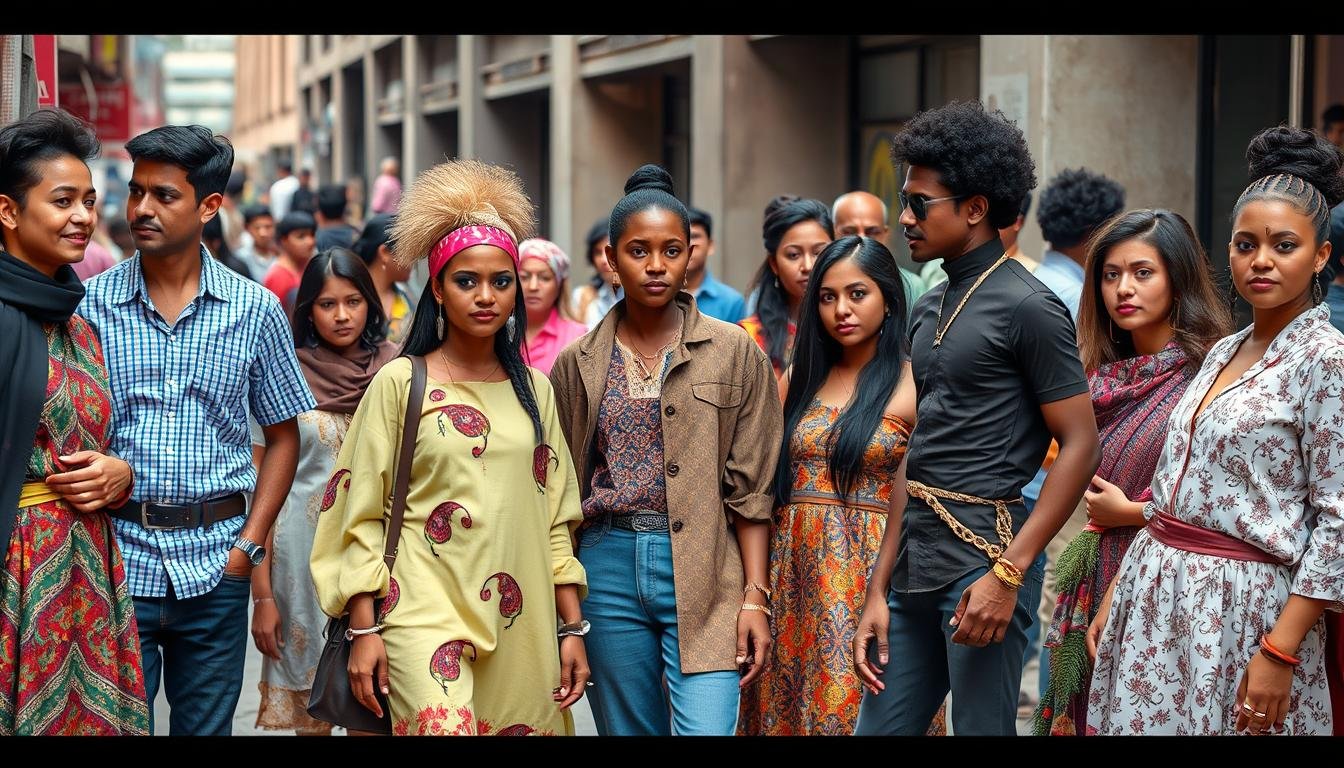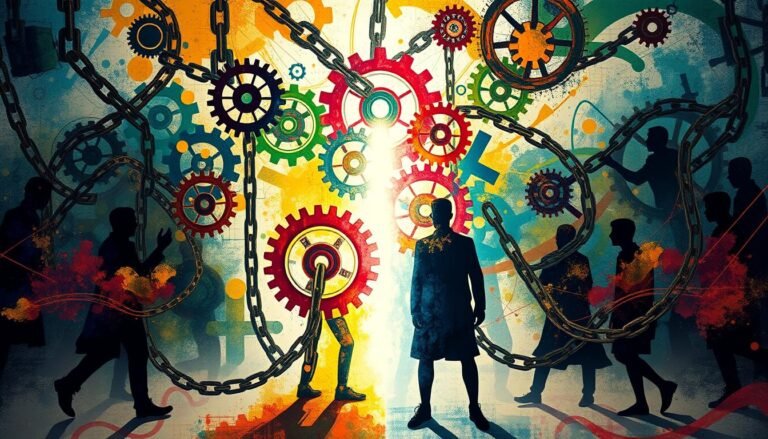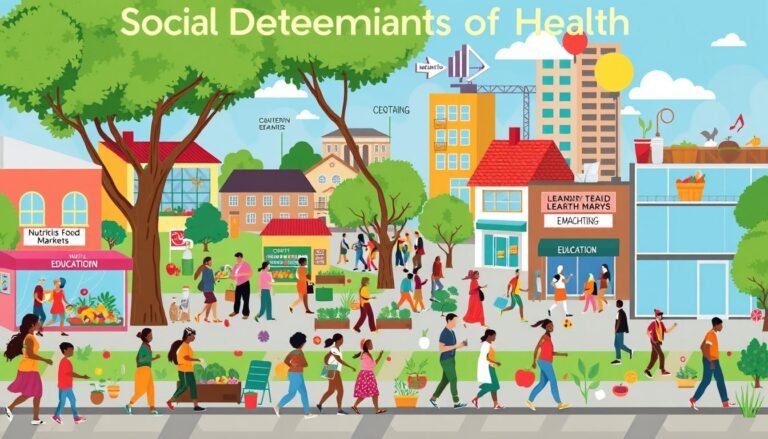Analyzing the Sociology of Fashion and Identity
Ever thought about how your clothes shape your identity and affect society? Fashion goes beyond just clothes and trends. It’s a key social tool that shows and shapes our cultures, beliefs, and how we express ourselves. From athleisure to punk fashion, what we wear tells a lot about us and our world.
The study of fashion sociology looks at how what we wear connects with culture and identity. It’s interesting to see how a simple t-shirt or jeans can be a way to express ourselves. For example, the mini-skirt in the 1960s was more than a fashion statement. It was a sign of women’s fight for freedom and empowerment.
Social media has changed how we see and use fashion today. Platforms like Instagram and TikTok influence our choices, and brands like Gucci and Louis Vuitton show off our status online. This mix of tech and fashion lets us express ourselves and connect with others worldwide.
But fashion is more than just following trends. It’s a mix of personal taste, cultural norms, and what society expects. The idea of “glocalization” in fashion shows how global styles mix with local touches, making unique styles that show our diverse world. Whether it’s formal wear that boosts our confidence or casual clothes that spark creativity, our fashion choices change how we act and how others see us.
Key Takeaways
- Fashion reflects and shapes societal changes
- Social media has transformed fashion consumption
- Luxury brands symbolize status in digital culture
- Clothing choices impact behavior and perception
- Fashion blends global trends with local elements
- Body positivity movements are challenging beauty norms
- Fashion serves as a tool for self-expression and identity
Introduction to Fashion Sociology
Fashion sociology looks at how clothes and society are connected. It shows how fashion acts as a cultural code, affecting how we act alone and together. This study became popular in the 1960s, when consumer culture was on the rise.
Definition and Scope
This field studies how clothes and trends affect society. It looks at how Social Norms shape fashion and how fashion shapes norms. It goes beyond just looking good, focusing on the deeper meanings clothes and accessories carry.
Historical Development
In the late 1960s and early 1970s, there was a big gap in fashion styles between older and younger people in Great Britain. By the late 1970s, what was once seen as radical fashion had become common among young people. This shows how fast fashion can change and adapt.
Key Concepts and Theories
Symbolic Interaction theory is key in fashion sociology. It says people use symbols, like clothes, to make meaning. Georg Simmel saw fashion as important in modern life. Diana Crane looked at how clothes show societal norms and how they can be broken.
Semiotics in fashion shows how clothes act like a language, sharing who we are and our social status. Edward Sapir linked fashion to our identity, showing its deep symbolic value. These ideas help us see how fashion shapes and reflects our social lives.
“Fashion is deeply egocentric and holds symbolic significance for ego expression over functional relevance.” – Edward Sapir
Fashion sociology sheds light on the cultural and structural forces that drive fashion changes. It shows how what we wear can mirror and strengthen social ranks. This makes fashion a key way to grasp society.
The Intersection of Fashion and Personal Identity
Fashion is a powerful way to express ourselves and shape our identities. Cultural studies show that what we wear reflects and shapes who we are. For instance, athleisure shows our focus on health and wellness.
Subcultures use unique styles to show dissent and unity. The rise of gender-neutral fashion shows changing views on gender identity. These choices boost our confidence and help us perform better at work.
The COVID-19 pandemic made loungewear more popular, showing fashion’s role in managing emotions. This change showed how clothes adapt to our needs and life changes.
“Fashion is not something that exists in dresses only. Fashion is in the sky, in the street; fashion has to do with ideas, the way we live, what is happening.” – Coco Chanel
Studies reveal that fashion, including clothes and accessories, is key to our collective identity. Social media lets us create new identities by sharing fashion choices.
| Fashion Element | Impact on Identity |
|---|---|
| Collective Styles | Shape gender and racial identity |
| Personal Styles | Constitute individual identity |
| Performative Aspects | Showcase identity through movement |
Cultural gerontology looks at how older people use clothes to show their social identity. It studies the link between fashion, aging, and cultural influences on identity at different life stages.
Fashion as a Form of Nonverbal Communication
Fashion lets us express ourselves without words. It shapes our identities and how we interact with others. Let’s see how what we wear sends messages about who we are and our role in the world.
Symbolic Interaction Theory
Symbolic Interaction theory shows how we make meaning through social interactions. In fashion, this means how we pick and understand clothes. For instance, a suit can mean professionalism in one setting but rebellion in another. Our clothes show our grasp of social norms and if we want to blend in or stand out.
Semiotics in Fashion
Semiotics looks at signs and symbols in communication. In fashion, every outfit is full of meaning. Colors, styles, and brands all have cultural meanings. A red dress might show passion, while a white suit could mean purity or power. Knowing these fashion signs helps us move through social situations and share our feelings.
Cultural Codes and Dress
Cultural fashion codes differ across societies and groups. They can show social status, cultural ties, or personal beliefs. For example, in some places, certain colors or patterns are only for specific times or social levels. These codes change with history, art, and social shifts.
Studies show that what we wear shapes who we are. Before, fashion was mainly for the wealthy, but now, the ready-to-wear industry makes style available to everyone. Yet, fashion still helps us deal with social norms, especially about gender and status.
“What you wear is how you present yourself to the world, especially today, when human contacts are so quick. Fashion is instant language.” – Miuccia Prada
Social Status and Fashion Choices
Fashion choices tell us a lot about social status. Throughout history, clothes have shown class and social rank. Cultural studies show how fashion is a way to talk without words, sharing wealth and position.
Today, brands like Gucci and Louis Vuitton show wealth. “Flex culture” on social media lets people show off their economic level through fashion. This matches old social norms about how we dress and our status.
What we wear says more than just our style. It can show our job, age, and even if we’re married. Anthropologist Joanne Eicher says dress is a way to share info about our life and where we stand in society.
“Fashion is dress in which the key figure is rapid and continuous changing of styles.” – Elizabeth Wilson
Fashion keeps changing, letting us keep rethinking what symbols of status are. From the Victorian era’s dress reform to today’s luxury brands, fashion keeps helping us show and shape who we are.
| Era | Fashion Statement | Social Implication |
|---|---|---|
| 1850s | Bloomers | Women’s rights and comfort |
| 1960s-70s | Youth vs. Older Generation Styles | Generational divide |
| Present Day | Designer Brands | Wealth and status symbol |
Analyzing the Sociology of Fashion and Identity
Fashion research looks at how clothes and social norms are linked. Scholars in cultural studies explore this link. They see how fashion helps shape who we are.
Methodologies in Fashion Research
Researchers use both in-depth and broad methods to study fashion. Ethnography and interviews give us a close look at personal stories. Surveys and statistics show us the big picture of fashion and social norms.
Case Studies and Empirical Evidence
Case studies give us a close look at specific fashion trends. For instance, a 2013 study by Aspers and Godart showed how fashion links to history and social theory. They saw fashion as a process of change that happens naturally in public.
Interdisciplinary Approaches
Fashion sociology combines different fields to understand style’s role in society. Spencer’s idea from 1897 talks about how middle classes copy fashion to show their status or hide their wealth.
| Researcher | Year | Key Concept |
|---|---|---|
| Aspers and Godart | 2013 | Fashion as unplanned recurrent change |
| Spencer | 1897 | Competitive imitation in fashion |
| Blumer | 1969 | Fashion change through interactional chain |
These studies show fashion as a mix of personal style, economic factors, and social norms. They tell us how society judges us by what we wear. This shows the deep connection between fashion and who we are.
The Role of Subcultures in Fashion Trends
Subcultures have always played a big part in setting fashion trends and challenging the usual norms. The punk movement in the 1970s in Britain is a great example. It shows how social and economic issues can lead to new ways of expressing oneself.
Back then, high unemployment among the young led to the rise of punk culture. The punk look was all about tight jeans, leather jackets, and ripped t-shirts, mainly in black and white. Designer Vivienne Westwood was key in creating the punk style, helping shape its look.
Punk was more than just fashion; it was a cultural movement. Bands like The Clash pushed the limits of music, showing punk rock’s power to go beyond the usual. This mix of music and style helped define the punk identity.
“Subculture: The Meaning of Style” by Dick Hebdige, published in 1979, offers a deep look into various subcultures and their styles.
The book talks about how groups like the teddy boys and skinheads used fashion to express themselves and challenge the norms. It shows the role of subcultures in big social and political changes.
| Subculture | Key Fashion Elements | Social Context |
|---|---|---|
| Punk | Leather jackets, ripped tees | Economic downturn, youth unemployment |
| Teddy Boys | Draper jackets, brothel creepers | Rejection of American influences |
| Mods | Sharp suits, parkas | Post-war consumerism, youth culture |
Looking into subcultures shows us how fashion trends often come from social, economic, and political issues. These movements still affect mainstream fashion, proving the lasting impact of subcultures on style and identity.
Gender, Sexuality, and Fashion
Fashion is key in shaping who we are and how we express ourselves, especially with gender and sexuality. The clothing industry has changed to show new views on gender identity and expression.
Historical Perspectives
Before, fashion stuck to strict gender roles. In World War II, designer Rudi Gernreich brought out unisex clothing, offering styles without gender labels. This move showed a growing need for clothes that fit everyone, not just men and women.
Contemporary Debates
Today, fashion celebrates diversity in gender expression. In 2015, Selfridges & Co. launched Agender, a store without gender labels. This was a big step towards making shopping welcoming for all gender identities.
Non-Binary Fashion
Non-binary fashion goes against old ideas of gendered clothes. In 2012, Saint Harridan started for trans men and masculine women. This trend lets people show their gender identity through what they wear.
| Year | Milestone | Impact |
|---|---|---|
| 2012 | Saint Harridan founded | Catered to trans men and masculine women |
| 2015 | Selfridges opened Agender | Promoted inclusivity in retail |
| 2015 | Same-sex marriage legalized in US | Increased demand for LGBTQ formal wear |
The fashion world keeps changing, welcoming different gender expressions and Self-Expression through clothes. This change shows how society is understanding and accepting more gender identities and sexualities.
Globalization and the Homogenization of Fashion
Fashion trends now spread fast around the world, mixing global and local styles. This trend, called “glocalization,” is a big topic in cultural studies. The fashion world is trying to keep a global appeal while respecting cultural differences.
Fast fashion brands have greatly spread fashion trends worldwide. This has led to more cultural sharing but also worries about losing local traditions. Now, social norms about how we dress are changing because of this global influence.
Globalization’s effect on fashion goes beyond looks. It changes how we see ourselves and our identities. People have to balance global trends with their local customs in their clothing choices.
| Aspect | Impact of Globalization |
|---|---|
| Cultural Exchange | Increased sharing of fashion trends across borders |
| Local Traditions | Risk of erosion due to homogenization |
| Identity Formation | Influenced by both global and local fashion elements |
| Economic Impact | Growth of fast fashion industry, job creation in local markets |
As fashion goes global, we must think about its effects on the planet and people. The industry needs to keep cultural diversity alive while meeting global demands.
The Impact of Social Media on Fashion and Identity
Social media has changed the fashion world. It now shapes how we show who we are and create our identities. Sites like Instagram let us share our style with people all over the world. This has made fashion more open, letting everyone have a say in what’s in style.
Instagram is great for fashion brands because it’s all about pictures. More than 62% of what we buy is because of the color. Burberry was one of the first luxury brands to use social media big time. They wanted to attract younger people and seem more trendy.
Social media has also started big talks in cultural studies. It lets different fashion groups and small communities be heard. Brands like Everlane use these platforms to talk about making fashion more sustainable. This shows how people want to make better choices in what they buy.
But, this new world of fashion online has its downsides. Trying to keep up a perfect image online can hurt our mental health and make us less true to ourselves. We need to find a way to enjoy sharing our style online without losing who we are.
“Social media has transformed fashion from a top-down hierarchy to a collaborative, global conversation.”
Ethical Considerations in Fashion Consumption
The fashion industry is under the spotlight for its ethical standards. Cultural Studies show how fast fashion impacts social norms and how we see ourselves. The rapid growth of the industry brings up big questions about sustainability, respect for cultures, and fair work conditions.
Fast Fashion and Sustainability
Fast fashion’s impact on the environment is huge. In 2020, the industry made $36.8 billion, with brands like Primark having over 370 stores in 12 countries. This huge production leads to a lot of textile waste and pollution.
Cultural Appropriation in Fashion
Cultural appropriation is a big debate. Fashion often takes ideas from different cultures without giving credit. This can turn cultural symbols into products, challenging our social norms and how we see ourselves.
Labor Issues in the Fashion Industry
Working conditions in fast fashion are worrying. Workers in developing countries make about $68 a month. This shows the need for better work conditions and fair pay in the industry.
| Aspect | Data |
|---|---|
| Fast Fashion Global Sales (2020) | $36.8 billion |
| Average Monthly Wage (Developing Countries) | $68 |
| Consumer Trend Awareness (Ages 18-34) | 63% |
| Fast Fashion Marketing Spend | $500 billion annually |
Consumers have a big role in making change. 63% of young people feel pushed to follow fashion trends. This need for new styles drives fast fashion, making choosing ethically important for a sustainable future.
Future Trends in Fashion Sociology
Looking ahead to July 29, 2024, fashion sociology is set for exciting changes. It’s moving towards sustainable practices, focusing on circular fashion and eco-friendly materials. This change shows a growing concern for the environmental impact of the fashion industry.
Identity formation through fashion is changing fast. Digital fashion and augmented reality are now ways to express oneself while being kinder to the planet. These trends remind us of the 1960s hippies and 1970s punks, where clothes showed off societal shifts. Now, social media platforms like Instagram and TikTok are shaping how we see and buy fashion.
The future of fashion sociology will focus more on diversity and inclusion. Brands are making changes in response to social movements, just like fashion has always done. New technologies will change how we show our identity through clothes. The mix of fashion with wearable tech also opens up new areas for study.
There are many ethical concerns in the fashion industry for researchers to look into. Topics range from the effects of fast fashion to sustainable practices and ethical issues. Designers like Stella McCartney, who uses organic cotton and recycled materials, could be key examples in this new fashion landscape.
Source Links
- Analyzing the Sociological Impact of Fashion Trends and Clothing Choices
- Sociology of Fashion
- Georg Simmel: Fashion
- Sociology of Fashion, Fashion and Social Life, Sociology Guide About Fashion
- Fashion Sociology: Definition and Meaning
- Crane, D. 2000. Fashion and Its Social Agendas.
- Dress is a Fundamental Component of Person Perception
- Microsoft Word – Altman, Madison – Thesis.docx
- Sociology Of Fashion Analysis – 963 Words
- Sociology Of Fashion
- The place of subcultures in the fashion world: [Essay Example], 3872 words
- SUBCULTURE: THE MEANING OF STYLE
- Ungendered: The Future of Fashion
- Sexuality
- Sociology of Gender
- Fashion Sociology
- Globalization and its Impact on Cultural Identity: An Analysis
- Globalization
- The Use of Social Media to Promote Sustainable Fashion and Benefit Communications: A Data-Mining Approach
- The fashion scandal: Social media, identity and the globalization of fashion in the twenty-first century
- The Sociological Perspective on Primark and Fast Fashion
- A Comprehensive Study of Sustainability, Fashion and Consumption: Understanding Consumer Behaviour and Clothing Evaluation from a Cross-national Perspective
- Fashion Research Paper Topics: From Runway to Research
- Fashion as a mirror of society







